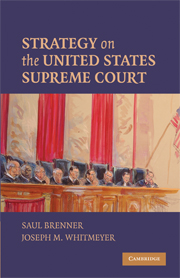Book contents
- Frontmatter
- Contents
- Preface
- PART I INTRODUCTION
- PART II CERTIORARI
- PART III THE CONFERENCE VOTE ON THE MERITS
- PART IV THE MAJORITY OPINION AND OTHER OPINIONS
- 8 The Extent of Successful Bargaining over the Content of the Majority Opinion
- 9 The Size of Opinion Coalitions
- 10 At Whose Ideal Point Will the Majority Opinion Be Written?
- 11 Reciprocity on the Supreme Court
- PART V THE FINAL VOTE ON THE MERITS
- PART VI CONCLUDING CHAPTERS
- Appendix 1 Decision Making on the United States Supreme Court
- Appendix 2 Additional Questions to Explore
- References
- Table of Cases
- Index
9 - The Size of Opinion Coalitions
Published online by Cambridge University Press: 05 June 2012
- Frontmatter
- Contents
- Preface
- PART I INTRODUCTION
- PART II CERTIORARI
- PART III THE CONFERENCE VOTE ON THE MERITS
- PART IV THE MAJORITY OPINION AND OTHER OPINIONS
- 8 The Extent of Successful Bargaining over the Content of the Majority Opinion
- 9 The Size of Opinion Coalitions
- 10 At Whose Ideal Point Will the Majority Opinion Be Written?
- 11 Reciprocity on the Supreme Court
- PART V THE FINAL VOTE ON THE MERITS
- PART VI CONCLUDING CHAPTERS
- Appendix 1 Decision Making on the United States Supreme Court
- Appendix 2 Additional Questions to Explore
- References
- Table of Cases
- Index
Summary
Rohde (1972) viewed opinion coalition formation on the Court as a bargain between the majority opinion writer and the other justices on the Court wherein the majority opinion writer will alter her ideal opinion in exchange for the other justices' votes. Although the majority opinion writer will desire an opinion that reflects her ideal position, she would be willing to modify it to obtain sufficient additional votes for it so that her opinion will be an authoritative opinion of the Court (also known as a majority opinion), instead of a plurality opinion. Four votes will be needed if eight or nine justices are participating in the case. The majority opinion writer, however, would be unwilling to change her opinion after a minimum winning (MW) vote is secured, and the other justices will not join the opinion unless additional changes are made. As a consequence, opinion coalitions on the Supreme Court will be MW.
This MW model pertains only to nonthreat cases (i.e., to cases in which no outside group is threatening the Court). In threat cases, Rohde argued, the Court is likely to form a united front against the threat. In other words, some justices would be willing to vote against their ideological predispositions to protect the Court against the threat.
This model is based on a number of unrealistic assumptions. First, Rohde assumes that the majority opinion writer will seek an opinion that reflects her views.
- Type
- Chapter
- Information
- Strategy on the United States Supreme Court , pp. 81 - 86Publisher: Cambridge University PressPrint publication year: 2009



